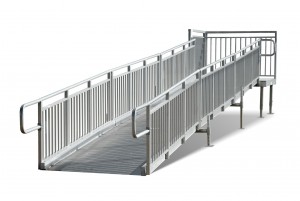If you’re worried that your facility isn’t in compliance with California ADA ramp requirements, the experts with REDD Team can help. REDD Team has helped school districts and other public entities across the state maintain ADA compliance for three decades, and we’ll be happy to do the same for you.
Why is ADA Compliance So Important?
 Congress passed the ADA (Americans with Disabilities Act) in 1991 to ensure that people with physical challenges would have the same type of access to public buildings as people without those challenges. Schools, churches, retail establishments and many, many other types of organizations had to comply, or face severe consequences. Failure to comply with ADA requirements can face extensive fines, or even expensive lawsuits.
Congress passed the ADA (Americans with Disabilities Act) in 1991 to ensure that people with physical challenges would have the same type of access to public buildings as people without those challenges. Schools, churches, retail establishments and many, many other types of organizations had to comply, or face severe consequences. Failure to comply with ADA requirements can face extensive fines, or even expensive lawsuits.
REDD Team ramps are designed to make sure everyone with mobility issues can safely and confidently enter and exit public buildings. They provide easy access to areas that would otherwise be impossible to reach. But they’re not just made for people in wheelchairs. Anyone who uses any sort of mobility aid, whether it’s a cane, a walker or anything else, can use our ramps with total confidence.
All of our ramps, stairs and other accessibility products not only comply with all ADA requirements, but also other codes as well. These include the following.
- Life Safety 101
- UBC
- IBC
- BOCA
- SBC
- SREF
How Do You Make Sure Your Ramps are ADA-Compliant?
The ADA requirements regarding wheelchair ramps are, as you would probably guess, extensive. Here are just a few of their ramp guidelines. Please talk to your city’s building inspector to learn more.
- The ramp must have flat sections at the top and bottom that are at least 5-feet by 5-feet. These sections must also be free of all obstructions.
- In order to ensure that any sort of accidental slipping doesn’t occur, the ramps must have protection along the edges.
- All surfaces have to be slip-resistant, and must also be designed in a way that they don’t accumulate water.
- If a ramp is to be more than 30 feet long, it must also provide an intermediate platform.
- Ramps must be at least 48 inches wide.
- For each inch of rise, there must be 12 inches of ramp. If you have a 20-inch rise from the ground to your building entrance, for example, you must have a 20-foot ramp.
- If your ramp has a rise steeper than 6 inches, or a length of more than 72 inches, then it must include handrails on each side. These handrails must be between 34 and 38 inches high.
Why is Aluminum the Best Material for a Wheelchair Ramp?
Wheelchair ramps come in many different materials, including steel, wood and concrete. However, aluminum is the clearly superior choice. These are just some of the reasons why this is the case.
- Steel will rust over time if not treated with a special (and expensive) coating. Aluminum has a built-in layer of protection against corrosion.
- Concrete is durable, but it’s also expensive. Also, you can’t reconfigure it like you can an aluminum ramp. You’d have to demolish the old one and build a new one.
- Wood can warp and rot, while aluminum will always maintain its structural integrity.
Learn More By Contacting REDD Team
The professionals with REDD Team are experts in California ADA ramp requirements. Please call (800) 648-3696 or contact us online to learn more about how we can help.
